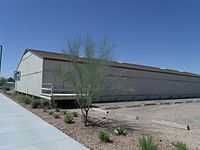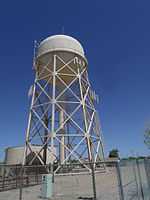Phoenix–Mesa Gateway Airport
| Phoenix–Mesa Gateway Airport | |||||||||||||||||||
|---|---|---|---|---|---|---|---|---|---|---|---|---|---|---|---|---|---|---|---|
 | |||||||||||||||||||
| IATA: AZA – ICAO: KIWA – FAA LID: IWA | |||||||||||||||||||
| Summary | |||||||||||||||||||
| Airport type | Public | ||||||||||||||||||
| Owner/Operator | Phoenix Mesa Gateway Airport Authority | ||||||||||||||||||
| Serves | Phoenix metropolitan area | ||||||||||||||||||
| Location | Mesa, Arizona | ||||||||||||||||||
| Focus city for | Allegiant Air | ||||||||||||||||||
| Built | 1941 | ||||||||||||||||||
| Elevation AMSL | 1,382 ft / 421 m | ||||||||||||||||||
| Coordinates | 33°18′28″N 111°39′20″W / 33.30778°N 111.65556°W | ||||||||||||||||||
| Website | PhxMesaGateway.org | ||||||||||||||||||
| Runways | |||||||||||||||||||
| |||||||||||||||||||
| Statistics (2014) | |||||||||||||||||||
| |||||||||||||||||||
Phoenix–Mesa Gateway Airport (IATA: AZA, ICAO: KIWA, FAA LID: IWA), formerly Williams Gateway Airport (1994–2008) and Williams Air Force Base (1941–1993), is in the southeastern area of Mesa, Arizona, and 20 miles (32 km) southeast of Phoenix, in Maricopa County, Arizona.[1] The airport is owned and operated by the Phoenix–Mesa Gateway Airport Authority, and is a reliever airport for Phoenix Sky Harbor International Airport. It is a focus city for Allegiant Air. The airport authority is governed by a six-member board: the mayors and tribal governor of the town of Gilbert, city of Mesa, town of Queen Creek, Gila River Indian Community, city of Phoenix, and the city of Apache Junction.[2]
The FAA's National Plan of Integrated Airport Systems for 2007–2011 called Phoenix–Mesa Gateway a reliever airport, which is a general aviation airport used to relieve congestion at a large airline airport.[3] Allegiant Air began scheduled service from Mesa in October 2007.[4] Phoenix Mesa Gateway Airport records say the airport had 1,242,237 passenger boardings (or approx.621,000 enplanements) in calendar year 2014.
Most U.S. airports use the same three-letter location identifier for the FAA and ICAO, but Phoenix–Mesa Gateway Airport is IWA to the FAA and AZA to the IATA (which assigned IWA to Yuzhny Airport in Ivanovo, Russia. The airport's former IATA code was CHD.[5]
History
The airport was built in 1941 and opened in 1942 by the United States military as Williams Air Base. It was a flight training field during World War II.
In 1948 Williams became the first jet training base, and in 1966 it was the first site of the Undergraduate Pilot Training (UPT) program.[6]
The 1991 Base Realignment and Closure Commission recommended closing the base as its operating costs were too high; the base closed in 1993.

As the base was being shut down, it was decided that, with the growing traffic at Sky Harbor International Airport in Phoenix, an alternative airport would be needed. The runway was expanded to accommodate airliners and the facility opened in 1994 as Williams Gateway Airport. Bids began for some airlines to begin flights almost immediately.
In 2004 charter airline Ryan International Airlines began MD-82 flights to Bullhead City International Airport in Bullhead City, Arizona, next to Laughlin, Nevada and many resorts.
In recent years, the airport has again become a center of flight training. Several large flight schools now take advantage of the flying weather in the Phoenix valley.
.jpg)
On July 31, 2007 the low-cost Las Vegas-based carrier Allegiant Air announced plans to open a focus city at Phoenix–Mesa Gateway Airport, connecting the Phoenix area to 13 cities. Service commenced on October 25, 2007, with cities being added until November 21, 2007.[4]
In a press release on September 17, 2007, the Williams Gateway Airport Authority governing board approved a name change for Williams Gateway Airport effective October 15, 2007 to Phoenix–Mesa Gateway Airport.
Facilities
The airport covers 3,020 acres (1,220 ha) and has three paved runways:[1]
- Runway 12C/30C: 10,201 x 150 ft (3,109 x 46 m) Asphalt/Concrete
- Runway 12L/30R: 9,300 x 150 ft (2,835 x 46 m) Concrete
- Runway 12R/30L: 10,401 x 150 ft (3,170 x 46 m) Concrete
In 2014 the airport had 228,368 aircraft operations, average 626 per day: 83% general aviation, 10% air taxi, 5% airline, and 2% military. 128 aircraft are based at the airport: 60% single-engine, 26% jet, 14% multi-engine, and 1% helicopter.[1]
The future
One of the biggest issues at IWA is the increase in passengers since Allegiant Air started operations. IWA did not anticipate this growth within the first year. Due to the increase from 14,588 enplanments in 2007 to 159,481 in 2008, facilities were becoming crowded. To alleviate this problem, extensive renovations and expansions have been completed, adding nearly 70,000 square feet. This added eight gates since IWA was established in 1994. The Airport broke ground on a final expansion plan in early 2013, to increase gates to ten. However, IWA is running out of real estate on the west side of the airfield, which will bring a halt to expansions until the east terminal facilities are complete.
East Side Terminal Plans
In response to the expansion issues, PMGAA has begun planning for a new east terminal. The plan titled, Gateway 2030, was developed in June 2012.[7] The Gateway 2030 plan outlines the process, major findings and recommendations associated with the cost feasible phasing approach to the development of approximately 700 acres of airport property and the supporting City infrastructure critical to ensure its success" (IWA, 2012b). The plan will be implemented in 4 phases. With the completion of phase one, IWA will be able to accommodate 1.5 million enplanements (3 million passengers). Much of phase one will address much needed access and infrastructure to access the new terminal. This includes access roads, parking, taxiways, aprons capable of Group III and IV aircraft, and the new 300,000 square foot pier concept terminal. The new terminal will have 14 gates, constructed in such a way to make room for 12 Group III and two Group IV aircraft.
Phase two has yet to be planned in detail, but will add another pier terminal to the main concourse, adding up to six gates, parking for 10,500 vehicles and a 1,000 foot extension of RW 12L/30R. Phase two will create the ability for IWA to handle 2.2 million enplanements. Phase three for the initial Gateway 2030 plan will add another pier terminal and second level to the main concourse and will create an additional eight gates, a new apron, more parking and an additional taxiway.
Phase three will focus on privately owned retail, office, and hotel buildings that will be located on airport property. Phase three will allow IWA to accommodate 5 million enplanements.
Phase four will complete the 2030 plan, allowing IWA able to handle 10 million enplanements (20 million passengers) annually with a total of 60 gates and 21,000 vehicle parking spaces. Phase four will likely not be undertaken until 2030 or beyond, making cost estimates nearly impossible.
Due to the changing market, phase two, three and four are likely to change. Gateway 2030 is estimated to cost upwards of $1.4 billion. The Gateway 2030 project will transform IWA into a new airport.
Airlines and destinations

| Airlines | Destinations |
|---|---|
| Allegiant Air | Appleton, Bellingham, Billings, Bismarck, Bozeman, Cedar Rapids, Chicago/Rockford, Cincinnati, Colorado Springs, Eugene, Fargo, Fort Wayne, Grand Forks, Grand Island, Grand Rapids, Great Falls, Idaho Falls, Las Vegas, Minot, Missoula, Moline/Quad Cities, Oakland, Ogden, Peoria, Provo, Rapid City, Sioux Falls, South Bend, Springfield/Branson, Stockton, Tri-Cities (WA), Wichita Seasonal: Medford, St. Cloud, Telluride |
Top destinations
| Rank | City | Passengers | Carriers |
|---|---|---|---|
| 1 | Bellingham, Washington | 30,000 | Allegiant |
| 2 | Fargo, North Dakota | 30,000 | Allegiant |
| 3 | Sioux Falls, South Dakota | 29,000 | Allegiant |
| 4 | Provo, Utah | 28,000 | Allegiant |
| 5 | Cedar Rapids, Iowa | 26,000 | Allegiant |
| 6 | Oakland, California | 24,000 | Allegiant |
| 7 | Las Vegas, Nevada | 22,000 | Allegiant |
| 8 | Bismarck, North Dakota | 21,000 | Allegiant |
| 9 | Minot, North Dakota | 20,000 | Allegiant |
| 10 | Rapid City, South Dakota | 20,000 | Allegiant |
Other
- Air Evac (Medevac airline)
- Fighter Combat International
Training
- Advanced Training Systems International, a fighter combat and maintenance training school
- Mesa Pilot Development
- ATP Flight School
- University of North Dakota Aerospace
- Chandler Gilbert Community College A&P Training
Board of Directors
In 1994, the Willams Gateway Airport Authority was established with a three-member board with representation from the three cities immediately adjacent to Williams Field. The original governing board consisted of the mayors of the town of Gilbert, city of Mesa, and town of Queen Creek, who continue as members today.
In later years, the Gila River Indian Community and the city of Phoenix joined the Williams Gateway Airport Authority board (now Phoenix Mesa Gateway Airport Authority). Gila River Indian Community joined in 1995 and the City of Phoenix joined in 2006. City of Apache Junction joined in 2013.
Now that the change of the Williams Gateway Airport name to Phoenix–Mesa Gateway Airport has occurred, the board approved resolution and ordinance does not change, diminish, give away, negate nor reduce any of the board of directors and their respective city, town or tribal government member voting authority and respective ownership. Phoenix–Mesa Gateway Airport continues to be owned and operated by the Phoenix Mesa Gateway Airport Authority.
A six-member airport Board of Directors is composed of elected officials from neighboring cities and a tribal government. Authority communities are as of 2014:
Historic landmarks
| Williams Air Force Base (now part of Phoenix–Mesa Gateway Airport) in Mesa, Arizona (NRHP = National Register of Historic Places) (MHP = Mesa Historic Properties) | ||||||||||||||||
|---|---|---|---|---|---|---|---|---|---|---|---|---|---|---|---|---|
|
See also
- Phoenix Sky Harbor International Airport
- Arizona World War II Army Airfields
- List of airports in Arizona
Notes
- ↑ 1.0 1.1 1.2 1.3 FAA Airport Master Record for IWA (Form 5010 PDF) effective 2013-01-10, AirportIQ 5010, GCR Inc.
- ↑ "Airport Authority Approves City of Apache Junction Membership". By Brian Sexton(Primary). Phoenix–Mesa Gateway Airport Authority. 29 July 2013. Retrieved 29 July 2013.
- ↑ National Plan of Integrated Airport Systems: 2007–2011, FAA, 2006-10-06
- ↑ 4.0 4.1 "Allegiant Air announces new base in Phoenix–Mesa", Press release (Allegiant Air), 2007-07-31
- ↑ Swartz, Karl L., "CHD – Location", Great Circle Mapper (GCMap.com)
- ↑ "The Southeast Valley Insider", The Arizona Republic, 2006-03-30
- ↑ "Gateway 2030: A Vision for the Northeast Area Development" (PDF), Press release (Phoenix–Mesa Gateway Airport), 2012-06-30
- ↑ Phoenix, AZ: Phoenix – Mesa Gateway (AZA) Scheduled Services except Freight/Mail, Bureau of Transportation Statistics, Research and Innovative Technology Administration, United States Department of Transportation, 2013, retrieved Oct 21, 2014
References
- Nelson, Gary; Thomason, Art (December 6, 2011), "Spirit Airlines to fly from Gateway Airport", The Arizona Republic
External links
- Phoenix–Mesa Gateway Airport, official web site
- Phoenix–Mesa Gateway Airport (IWA) at Arizona DOT airport directory
- Williams Air Force Base at GlobalSecurity.org
- FAA Airport Diagram (PDF), effective April 30, 2015
- FAA Terminal Procedures for IWA, effective April 30, 2015
- Resources for this airport:
- FAA airport information for IWA
- AirNav airport information for KIWA
- ASN accident history for CHD
- FlightAware airport information and live flight tracker
- NOAA/NWS latest weather observations
- SkyVector aeronautical chart, Terminal Procedures

